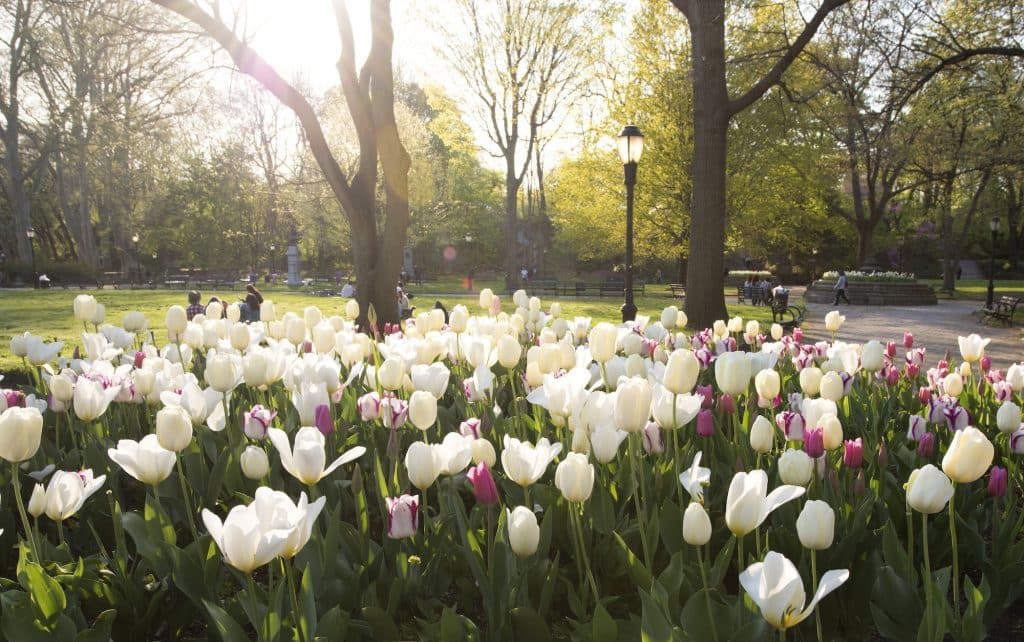What We’re Planting in the Park This Spring
April 13, 2022
Spring has sprung in Prospect Park! Prospect Park Alliance gardeners and volunteers are putting on their gardening gloves and preparing for our seasonal planting. This spring, our Landscape Management team is preparing to add 10,953 plants to the park, including: 171 trees, 338 shrubs, and 10,499 herbaceous plugs.
Prospect Park comprises 585 acres of rolling meadows, waterways and woodlands in the heart of Brooklyn, and is home to the borough’s only lake and last remaining forest. This landscape, beloved by Brooklynites, is also an essential wildlife habitat and hosts 250 species of birds and other important flora and fauna. For over 30 years, Prospect Park Alliance has overseen the park’s natural areas, and major improvements have been made to the entire park ecosystem. This spring’s plantings continue this essential work to keep the park green and vibrant.
Many of the new trees will be planted as part of the Alliance’s Commemorative Giving program, an opportunity for the public to donate a tree to the park in honor of a loved one or for a special occasion. These additions help replace lost trees and ensure the ecological health of the park.
These trees, shrubs, and herbaceous plugs are destined for areas throughout Prospect Park. The southern shore of the Peninsula will receive native wetland plants in an effort to prevent the further erosion of the Lake edge and the expansion of the invasive phragmites, while creating a visually appealing native waterfowl habitat. At the Butterfly Meadow atop Lookout Hill, volunteers have done extensive work clearing the area of undesirable invasive plants to make way for more beneficial species.
One of the spring’s largest plantings will take place in the landscape surrounding the LeFrak Center at Lakeside. Alliance staff have been hard at work this winter experimenting with sheet mulching in anticipation of the new plant additions in the area. “It will be interesting to see how the sheet mulching works,” says Ecozone Gardener AJ Logan. “Even before we plant new things we are already seeing some of both our friends and foes of the plant world sneaking in around the edges of the cardboard.”
The plantings at Lakeside will include a variety of species well suited for our area, and selected for their ecological benefits within our ecosystem. One addition, the Red Chokecherry, (Aronia arbutifolia), is a native shrub in the rose family with attractive white flowers in the spring and intense red and orange foliage in the fall. Its pollen and nectar provide food for native pollinators, and its berries are a winter source of food for birds. Another, Sweet pepperbush (Clethra alnifolia), has fragrant, bottle-brush like blooms of white flowers that attract a variety of pollinators in the summer.
The most important way the public can help these new plantings? “I’d like for visitors to know that when people and pets go into the horticultural beds, they can easily damage plants, particularly young perennials, and can contribute to soil compaction and erosion,” says Lakeside Lead Eco Zone Gardener Corbin Laedlein. “Please don’t wander into the beds and keep your dogs leashed at Lakeside.”
The sentiment is echoed by Eco Zone Gardener Jesse Brody, “with continued hard work, time and resources, I’m hopeful that we can get the LeFrak greenroof back to its pre-Covid state of being a landscape that serves important ecological functions and appears more worthy of the public’s respectful treatment.”
Learn more about Prospect Park Alliance’s work to sustain the environment.

